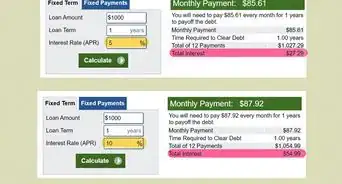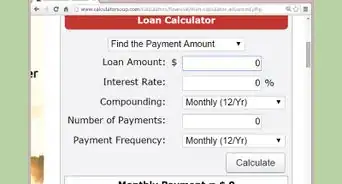This article was co-authored by Ryan Baril and by wikiHow staff writer, Jennifer Mueller, JD. Ryan Baril is the Vice President of CAPITALPlus Mortgage, a boutique mortgage origination and underwriting company founded in 2001. Ryan has been educating consumers about the mortgage process and general finance for almost 20 years. He graduated from the University of Central Florida in 2012 with a B.S.B.A. in Marketing.
This article has been viewed 161,156 times.
As a loan processor, you put together information about a borrower and organize it in a neat package so the underwriter can evaluate and approve the requested mortgage. You'll open the loan file, verify the borrower's information, and submit the package to the underwriter for an ultimate decision. Although specific steps may vary depending on your employer and any federal, state, or local laws, the basic steps to process a loan are roughly the same.
Steps
Opening the File
-
1Contact the loan officer. The loan officer acts as the intermediary between you and the borrower, and they can answer any questions you have about the loan. If you have any questions about the information, the loan officer can answer them.[1]
- Read through the application and other documents received first to make sure you understand everything about the loan before you get started with the processing. If you have any questions, it's better to ask them as soon as possible.
-
2Enter loan information into the computer system. The bank or lending company where you work will have its own system for entering information about each loan you process. Enter the information you've received accurately and completely.[2]
- If the computer system prompts you for information you don't have in the loan file you received, contact the loan officer as soon as possible so you can get this information filled in.
- The computer system will generate deadlines for various processing steps to be completed, and may send you reminders when a deadline is approaching.
Advertisement -
3Order the borrower's credit report. If the borrower was pre-approved, the loan officer may already have pulled the borrower's credit report and included it in the information sent to you. If not, you'll have to order one.[3]
- You may need a credit report from each of the three major credit reporting bureaus. If the loan officer only checked one, you may still need to order the other two.
-
4Order an inspection or appraisal. The mortgage company may require an inspection or appraisal of the property being purchased before the loan can be approved. Depending on your employer's rules, it may be your responsibility as a loan processor to order these.[4]
- Since inspections and appraisals can take time, if you know you need to order them, do so as soon as possible during processing.
- The underwriter will review the inspection and appraisal to determine the value of the collateral for the loan. Some states may have additional requirements, such as certification that there are no termites on the property.[5]
-
5Start a title search. The title search for the property will reveal whether there are any outstanding liens or other claims against the title, which could affect the value of the property.[6]
- It's possible that the loan officer has already set the wheels in motion for the title search, or you may be responsible for handling this on your own.
Verifying Borrower Information
-
1Check the borrower's income sources. The borrower's income is perhaps the most important part of their loan package, because it determines their ability to pay back the loan. Typically you'll be looking at the borrower's tax returns or pay stubs going back a couple of years.[7]
- The borrower's education and employment history can be just as important as the amount of their income.
- For example, if you have a borrower in their mid-20s who just graduated with a professional degree and has started working full-time in that field, their income probably will increase as they gain experience in their field.
- You may need additional information to verify the borrower's income if they are self-employed. Request this information as soon as possible to avoid any unnecessary delays.
-
2Evaluate the borrower's assets. The borrower may have other property that either could generate income on its own or could be liquidated to pay debts if necessary. The value of these assets will affect the amount of the loan that gets approved.[8]
- Assets are particularly important if the borrower has limited or fixed income, perhaps because they're retired.
- When assessing value here, take into account whether the borrower has used that property as collateral on another loan.
-
3Analyze the borrower's outstanding debts and credit history. The borrower's credit report provides a snapshot of how that borrower handles credit. Compare their outstanding debt to their income, and check for missed payments.[9]
- Your employer will have basic standards that must be met. If the borrower doesn't meet these standards, they may need to provide additional information. For example, if a borrower has an unacceptable number of late payments on their report, the lender may require an explanation.
-
4Get proof of insurance. All lenders require borrowers to prove that they have homeowner's insurance, or can get homeowner's insurance for the property. Your employer will have set coverage standards that must be met.[10]
- Homeowner's insurance protects the property, which is being used as collateral for the loan. While the homeowner is still paying their mortgage, the insurance protects the lender as well as the homeowner from loss.
- If proof of insurance wasn't submitted with the original loan application, work with the loan officer to get documentation from the borrower.
Submitting the File to the Underwriter
-
1Review the file. Before you send the file off to the underwriter, take a moment to look through all the information and documents in the file and make sure everything is complete and accurate. Check for errors and contact the loan officer if you need clarification on anything.[11]
- As you review the file, note any possible red flags or other cause for concern. This saves the underwriter some time as they go through the file.
- Make sure the file follows the underwriter's formatting and organization guidelines. If documents or information are presented in the wrong order, it could impact the loan's approval.
-
2Request any additional reports of documents. The underwriter requires specific documents and information in each loan file. If you found missing documents in your review, contact the loan officer as soon as possible.[12]
- If you've found any red flags, you also might want to get the borrower to explain them. For example, suppose the borrower missed three payments on a car and had it repossessed. The borrower may be able to provide information that would help excuse them for that fault.
-
3Forward the loan package to the underwriter. Once you're satisfied that everything in the loan package is complete and in an acceptable form, it's ready to move on to the underwriting process.[13]
- You may be required to send the package through a supervisor first, who will review your work and point out any changes that should be made. This is especially likely if you're just starting out as a loan processor.
-
4Work with the underwriter to resolve any problems. The underwriter may issue a "suspense" on the loan if they require more information for processing. They may go directly to the loan officer for this information, but frequently as a loan processor you will act as an intermediary between the underwriter and the loan officer.[14]
- In some cases, such as if the issue is related to a note or comment you made on the file, the underwriter may go to you directly for an explanation.
Expert Q&A
-
QuestionWhere does the file go after underwriting?
 Ryan BarilRyan Baril is the Vice President of CAPITALPlus Mortgage, a boutique mortgage origination and underwriting company founded in 2001. Ryan has been educating consumers about the mortgage process and general finance for almost 20 years. He graduated from the University of Central Florida in 2012 with a B.S.B.A. in Marketing.
Ryan BarilRyan Baril is the Vice President of CAPITALPlus Mortgage, a boutique mortgage origination and underwriting company founded in 2001. Ryan has been educating consumers about the mortgage process and general finance for almost 20 years. He graduated from the University of Central Florida in 2012 with a B.S.B.A. in Marketing.
VP, CAPITALPlus Mortgage After underwriting is completed, and assuming the underwriting decision was an approval, the file will go to closing.
After underwriting is completed, and assuming the underwriting decision was an approval, the file will go to closing. -
QuestionDoes approval come before or after underwriting?
 Ryan BarilRyan Baril is the Vice President of CAPITALPlus Mortgage, a boutique mortgage origination and underwriting company founded in 2001. Ryan has been educating consumers about the mortgage process and general finance for almost 20 years. He graduated from the University of Central Florida in 2012 with a B.S.B.A. in Marketing.
Ryan BarilRyan Baril is the Vice President of CAPITALPlus Mortgage, a boutique mortgage origination and underwriting company founded in 2001. Ryan has been educating consumers about the mortgage process and general finance for almost 20 years. He graduated from the University of Central Florida in 2012 with a B.S.B.A. in Marketing.
VP, CAPITALPlus Mortgage Approval of the loan comes from underwriting. In most cases, the underwriter will issue a conditional approval, then the processor will obtain and submit the conditions and will be issued either a new conditional approval or a final approval.
Approval of the loan comes from underwriting. In most cases, the underwriter will issue a conditional approval, then the processor will obtain and submit the conditions and will be issued either a new conditional approval or a final approval.
References
- ↑ https://www.universalclass.com/articles/business/finance/loan-processing-step-by-step.htm
- ↑ https://www.universalclass.com/articles/business/finance/loan-processing-step-by-step.htm
- ↑ https://www.universalclass.com/articles/business/finance/loan-processing-step-by-step.htm
- ↑ https://www.rubyhome.com/home-loans/mortgage-loan-process/
- ↑ https://www.universalclass.com/articles/business/finance/loan-processing-step-by-step.htm
- ↑ https://www.rubyhome.com/home-loans/mortgage-loan-process/
- ↑ https://www.pennymacusa.com/blog/explaining-the-loan-process-part-3-processing
- ↑ https://www.pennymacusa.com/blog/explaining-the-loan-process-part-3-processing
- ↑ https://www.pennymacusa.com/blog/explaining-the-loan-process-part-3-processing
- ↑ https://www.pennymacusa.com/blog/explaining-the-loan-process-part-3-processing
- ↑ http://www.loansafe.org/what-does-a-loan-processor-do
- ↑ http://www.pennymacusa.com/blog/explaining-the-loan-process-part-3-processing
- ↑ http://www.thetruthaboutmortgage.com/what-do-loan-processors-do/
- ↑ http://www.thetruthaboutmortgage.com/what-do-loan-processors-do/
About This Article
To process loans, start by contacting the loan officer and entering the loan information into the computer system. Next, order the borrower's credit report, evaluate their assets, obtain proof of insurance, and research their income sources and employment history. Review everything in the file closely for accuracy, make note of any red flags, and put it all together according to the underwriter's formatting and organization guidelines. Once you're satisfied that everything in the loan package is complete, forward it to the underwriter. For more tips on preparing documents for an underwriter, read on!











































































